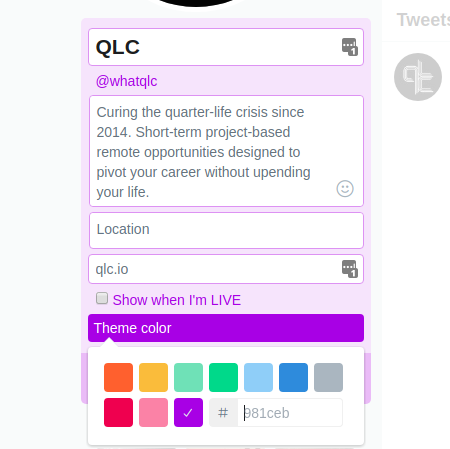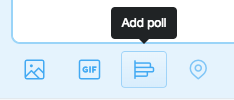Growth Hacking Twitter
Introduction
Twitter is a much more minimalistic platform than, let’s say, Facebook, as is evident by their 280 character limit. It focuses on facilitating conversations first, profiles second, with communities being a natural product of the two, in place of being defined as a group, forum, sub, etc.
Account Setup
Setting up your twitter account is pretty straightforward, and is composed of the following components.
* Username (@UserName)
* Title
* Bio
* Header photo
* Profile photo
* Location
* Website
* Theme Color
* Birthday
In order to set up all of our image assets quickly and easily, we’re gonna be using a free tool called ArtStudio courtesy of Postcron, that should take care of the image sizes and allow us to design them with ease.
Twitter images placed in your profile are static, so animated gifs or short videos aren’t a viable possibility for any images save for the ones in your tweets.
Username
First, we’ll fill in our @UserName, which will preferably be our brand name alone, though if it’s taken we might need to add a word or two. We’ll try to make it as short, memorable, and in line with our brand voice as possible.
Title
Once we have our username we can add our Title, which should be our brand name without any additions to it. This is not a unique value like the @UserName so duplication isn’t a problem and you may choose whatever title you’d like.
Bio
Here we’ll write a short, 160 character, description which should deliver what we do and what’s our value to new users encountering our profile.
Header photo
Image Specs: 1,500 x 500 pixels, 5MB maximum size
The header photo works with our theme color to create our brand presence on twitter viewable for those specific users that are visiting our profile.
Profile photo
Image specs: 400x400px, 2MB maximum size
Display specs: 200x200px and below
Generally, it would be our company logo, unless otherwise instructed.
Location
If you’re working on an online brand it’s best to leave this field blank, though if you’re working on a brand for a small or medium business (SMB) such as a local restaurant, hair salon or computer repair shop, then do make sure to let people know where they can find you.
Website
Just put the URL to your website, such as www.qlc.io
Theme Color
While it’s tempting to choose what you like from the rainbow of colors available, make sure to choose the main color of your brand palette which can be on your website or requested from your PM.
ColorZilla is a great tool for extracting colors from web pages and into color-hex-codes which can be easily inserted into twitter’s color settings.

Birthday
While some startups might want to put their founding date here, most brands would prefer to leave it blank.
Our Twitter profile is all set up
Easy-peasy!
Now the first thing you’ll want to do right after finishing up your twitter profile is tweet a single marketing message directing to your website registration or purchase which should include a video or picture and a call-to-action (CTA) such as “Start your Free Trial Now”, “Buy Now”, “Read More” etc.
This will allow new users visiting your profile to see exactly what you’re all about. Don’t expect it to get any actual engagements though.
Last but not least we’ll access our twitter dashboard at TwitterDeck which will allow us to manage our brand content much more comfortably.
Organic Marketing
Branding
Due to its limited amount of content per tweet, low levels of engagements per tweet, and saturated content conditions, successful Twitter accounts are tweeting 10-50 times per day.
Unlike other platforms where batch posting may be harmful to a brand’s social presence, on twitter it’s considered all right and due to the character cap, a lot of users are using several tweets to deliver one message.
Using curated and organic content (around a 60% / 40% ratio), we’ll start scheduling 5~10 daily tweets using either SMM platforms such as dlvr.it and Hootsuite or Twitter’s own TwitterDeck. Add to that our retweets, and attempts at community engagement and we’re up to ~30 tweets per day.
We’ll also make sure to retweet any positive @mentioning of our account.
Community Reach
Twitter is a giant community facilitating many different conversations, so community engagement is where it really shines.
In order to locate our target audience, we’ll be using social analytics tools to find relevant keywords and follow successful brands and personal accounts who are reaching out to similar audiences, this should open us up to real conversations currently happening within our market niche.
In order to engage with our target audience we’ll jump in on those conversations via @mentions and #hashtags, not so we can market our product but to genuinely offer value and insights to the conversation and the users we’re interacting with.
Some of those tweets would require us to do some research in order to truly offer said value, good thing we’re scrappy hard workers.
Marketing
Quick reminder, marketing messages are those specific tweets aimed at converting users to purchase, register and use your product.
We’re gonna schedule 1~2 marketing tweets per day which should include a call-to-action (CTA), and an image, link or video. Depending on the context of our conversations in the Twitter community, we’ll appropriately add @mentions and #hashtags, all the while being very careful not to come off as spammers.
Social Analytics
Market Research
Given how Twitter is composed of both users and conversations, market research is also split into researching brands and accounts, and researching #hashtags, keywords, and conversations, these two while separate are intertwined so when we’re researching conversations we might find new and engaging accounts to follow, and vice versa.
OKRs
Below are several suggested OKRs & KPIs aimed at measuring your continuous success on Twitter.
- Reach
* Profile Visits
* Tweet Impressions
* Daily Impressions
* Profile Followers
- Engagement
* Brand Mentions
* Retweets
* Tweet Replies
* Tweet Favorites
* Tweet Clicks
* URL shares
* Branded Hashtags
- Behaviour & Conversion Rate
* Measured on our own domain via GA, Mixpanel etc.
For suggested KPIs check SMM Fundamentals.
Social Media Optimization (SMO)
There are many different tactics available for you to try out and optimize in order to best reach and engage your audience. Below are several of those for your inspiration. I’d advise against counting on them alone but continuously research what sort of tactics have worked or might work well for your brand, industry and audience, and do not forget to measure the result of the tactics you engage against your original OKRs, in contrast to counting on any and all available metrics which might result in a focus on vanity metrics with no real impact on the business.
Opinion Polls
Asking for user opinions could be highly engaging to our existing following as well as target audience, giving them an opportunity to offer their own insights on the subject at hand, be it product-feedback, content-decisions or even just-for-fun.
You can run your polls in several different manners, each with their own set of tradeoffs.
Twitter Polls

Allows for up to 4 different answers, closes polling within 24 hours, presents overall engagements, but doesn’t show which user voted which way.
Retweet vs. Like
Asking users to Retweet in agreement and Like in disagreement is a surefire way to get both polling results per user, as well as get more reach and impressions without a time limit.
#hashtagged answers
Another way to run a poll is offering the users several #hashtags to tweet as answers, this also allows the user to elaborate their answer, as well as expand your reach, remove the time limit, and enable seeing results per user.
In this article by buffer, besides an in-depth description of Twitter’s poll feature, there are several case studies describing how brands have used the feature to engage their audience.
User Generated Content (UGC)
Asking your user-base for their content, images, videos, opinions or take on a brand-related-subject via #hashtagged or @mentioned tweets could be highly advantageous, although, timing, authenticity, and customer-care issues could result in a backlash bigger than any campaign.
This article presents some of these backlashes from brands attempting to engage UGC.
Prized Contests & Promotions
There could be no better way to engage your audience, generate hype, leads, subscriptions, conversions, and even UGC, like a prized contest. You may choose your winner in any number of ways, either editors-pick, most engagements collected, at random, or even give a prize to all participants as a promotion. Your prize must be something that users find valuable, but also something that’s connected to your brand. You can even give out coupons for your services at reduced prices.
This article covers several success stories of brands engaging in promotions & contests
TweetChat
Similar to Reddit’s AMA (Ask-Me-Anything), TweetChats are a prescheduled Q&A with a person of interest on our brand’s account. It could be with a company director or employee, or even a 3rd party influencer. Tweetchats are hosted via a specific #hashtag for the conversation, thus any tweets using the hashtag during the Q&A timeframe, are monitored via tools such as Twubs TwitterDeck or simply via Twitter’s own search function. It’s highly important to promote the TweetChat several days before it takes place, use a unique hashtag for the conversation and pick an appropriate time when your target audience is most engaged.
Here’s a brief case study of Hero MotoCorp’s #RideSafeIndia campaign.
Also, This article on the medical #ChatAFib tweetchat, tells the story of an award-winning campaign.
Live Stream (via Periscope)
Similar to FB Live, Periscope is Twitter’s social live streaming service, offering to live stream and publish videos for up to 24 hours, at which time the video is removed. Broadcasting on periscope in conjunction with a targeted twitter campaign can work wonders for a brand. Asking user opinions and offering prizes like Delissio’s case study, could work wonders as well.
Here’s a case study of Turkish Airlines combined Twitter & Periscope campaign.
Engaging Content
It’s no news that Twitter is highly news-oriented, most likely being the first platform with breaking stories and insights. Using tools such as Google alerts and google trends is a great way to create high-performing news content, though it’s advisable to connect the content to your brand. Product and industry.
This post on Twitter’s Blog offers some more insights on the best ways to engage your audience.
Tools & Templates
Below are several products, services, and references to assist you in tackling the challenge of hacking your growth in reach and engagement.
| TYPE | PRODUCT |
|---|---|
| Engagement Analytics | Twitter Analytics |
| Impression Analytics | Twitter Ads |
| Keyword Research | Hashtagify |
| #Hashtag base live conversation tool | Twubs |
| Location based keyword research | TrendsMap |
| Community Analytics Tool | Twitonomy |
| Account Analytics Tool | TweeTails |
Conclusion
While Twitter can be a bit of an exhaustive affair, demanding a lot more content and attention to ongoing conversations throughout the day, it’s exactly those fluid communities and conversations that offer even relatively new and unrecognized brands a viable opportunity to shine.